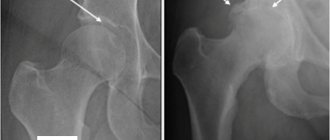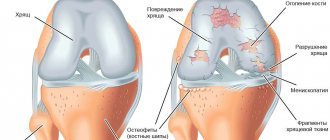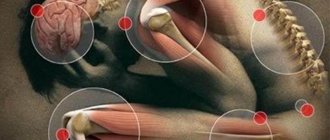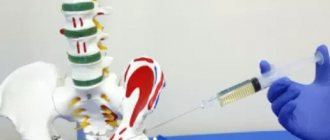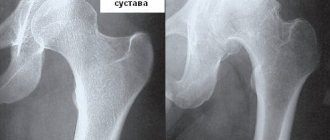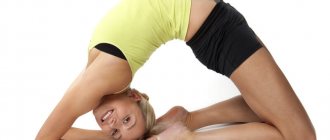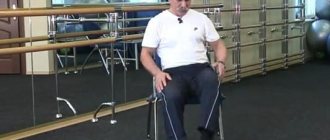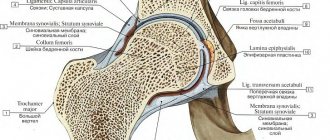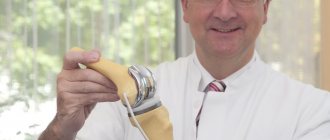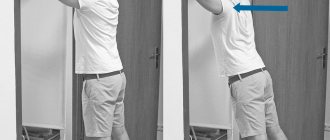Author of the article: Alexandra Burguta, obstetrician-gynecologist, higher medical education in the specialty “General Medicine”.
Article publication date: 11/09/2013
Article updated date: 12/06/2020
According to sad statistics, coxarthrosis (arthrosis of the hip joint) affects from 3 to 16% of the world's population. This is a severe degenerative-dystrophic pathology of the musculoskeletal system, which is characterized by a progressive course. An obligatory component of therapy is therapeutic exercises - the simplest and most natural method of getting rid of joint diseases. However, like any other method of treatment, it should be carried out under the supervision of a doctor, since incorrectly selected exercises (and their incorrect execution) can only aggravate the development of the disease.
Tasks and features of exercise therapy
All therapeutic measures for patients suffering from coxarthrosis are aimed at reducing pain, strengthening ligaments and muscles, and slowing down the destruction of articular cartilage.
Regularity of classes is the most important condition for exercise therapy. Proper gymnastic exercises help improve joint stability and stretch and relax the hip flexor and extensor muscles.
The treatment process uses dynamic (moving) and isometric (static) exercises, in which the muscles are tensed without moving the body itself. In this case, the range of motion in the hip joint should be within the limits of preserved mobility (before pain occurs). Numerous studies have proven that even with severe pathological changes in the joints, patients with a well-trained muscular system develop compensatory (adaptive) mechanisms*. But their formation requires long-term systematic training.
* Compensatory mechanisms are reflex reactions aimed at eliminating or weakening functional changes in the body caused by the environment, diseases, etc.
For a patient suffering from arthrosis of the hip joint (HJ), exercise therapy exercises are recommended that strengthen the ligaments and muscles, but do not force the joint to excessively extend and flex.
How to test for signs of disease?
Clinical manifestations of pathologies of the hip joints are accompanied by pain symptoms in the back, knees and/or groin area. You can test the articular surfaces of the musculoskeletal system yourself at home.
Lying on your stomach, you should bend the limb and move it to the side. The presence of pain indicates the presence of a specific medical problem. The next test is performed while lying on your back. The bent leg at the knee should move freely in a circular motion.
The hip joint is a circular sliding surface that should rotate without restriction along a trajectory reminiscent of the figure "8". As soon as a pain sign limits the degree of freedom of the hip joint, it is a sign of the presence of a certain type of articular pathology.
A weak joint means weakened muscles , insufficiently functional main blood circulation, and the risk of sprain and/or rupture of the ligamentous apparatus.
TBS testing video:
Rules for performing gymnastics
- In case of arthrosis of the hip joint, the physical activity recommended for the patient should not have a negative effect on the articular cartilage. Gymnastics should be performed daily, that is, turn this need into a useful habit that will help ensure good blood supply and mobility to the hip joint.
- Therapeutic gymnastics for arthrosis involves choosing a starting position that does not increase the load on the joint. During classes, increasing the load should occur by increasing the number of repetitions and the total number of exercises.
- Many patients are recommended dosed weights. For this purpose, a special cuff or rubber band is used, which is fixed on the ankle. Each exercise with weights should be performed slowly, without expanding the range of motion.
- Breathing during exercise should be voluntary.
- Any exercise ends with raising your arms up (inhale) and lowering your arms down (exhale).
Recommendation. It is advisable to combine gymnastics with self-massage of the thigh and gluteal muscles. To do this, you can use special massagers that are commercially available.
Rules for performing a set of therapeutic exercises
Physiotherapy exercises are, first and foremost, training. The difference between therapeutic training and training for athletes is that sports training is designed to put maximum stress on the body to achieve high results.
Therapeutic exercise is aimed at the load necessary in the daily life of an ordinary person. The main aspect of the set of exercises is the ratio of the load and the capabilities of a particular person.
When applying a therapeutic set of exercises for the hip joints, the following rules should be observed:
- Systematicity. A qualified specialist selects physical activities and their sequence, taking into account the characteristics of the functional disorders of a particular person. Do not neglect the doctor’s opinion and change treatment measures at your own discretion.
- Duration of use of therapeutic exercises. Only long-term use of the complex gives a good therapeutic effect. Single sessions will not only not help, but can also cause harm.
- Regularity of classes. If you interrupt therapeutic physical activity, the achieved result will disappear. You'll have to start all over again to achieve lasting results.
- Increasing load. Under the supervision of a specialist, the intensity of the exercises will increase. But in no case should you increase the load on your own - this will negatively affect your health, and the results obtained will be lost.
- Classes should bring joy and pleasure.
Exercise is a powerful tool for functional healing.
The best exercises for arthrosis of the hip joint
1. IP (starting position) – lying on the floor, on your stomach. Arms along the body, legs straight. Slow lifts are performed with a straight leg 15 degrees from the floor, holding it in this position for 30-40 seconds. Then the legs are changed. This exercise can only be performed once with each leg (per workout). All movements are performed due to the efforts of the thigh and gluteal muscles.
Then the same movement is performed in a dynamic version: the legs straightened at the knees are slowly and smoothly alternately raised up and held for 1-2 seconds at the top point. During the entire exercise therapy session, 10-12 lifts should be performed.
2. I.P. - lying on his stomach, arms along the body. The right leg is bent at the knee at a right angle, the left leg is straight. The exercise is performed in the same way as the previous one. In the static version - once with each leg, in the dynamic version - 10-12 times. Then the legs are changed.
3. I.P. - lying on his stomach, on the floor. Legs are straightened, arms are extended along the body. Very slowly, straight legs are raised up to an angle of 15° from the floor, held in weight, and then smoothly spread and brought together (8-10 times).
This exercise is not recommended for patients with high blood pressure, as well as people over 40 years of age.
4. I.P. - lying on the right side with the right leg bent at the knee, the left leg straight. For about 30 seconds, you need to keep your left leg suspended (45°), and then, after a short rest, roll over onto your right side and perform the same movement with your right leg.
5. I.P. - sitting on the floor, legs straightened. Without bending your knees, you need to lean forward and try to clasp your feet or toes with your palms. Pulling your body forward, you need to stay in this position for a couple of minutes. Perform no more than once a day.
If this exercise is performed regularly for several months, the muscles of the back and hips will stretch, and the angle of inclination will double. As a result, the blood supply to the legs will improve, and muscle spasms in the hip and lower back will disappear.
In physiotherapeutic practice, many similar exercises are used in the treatment of arthrosis of the hip joint, but all of them must be prescribed individually by a physical therapy instructor. This takes into account the stage of the pathological process, as well as the individual characteristics of the patient.
Therapeutic gymnastics for hip joints
These videos present a set of exercises for treating hip joints.
The exercises from our video are useful for diseases of the hip joints:
- with coxarthrosis - arthrosis of the hip joints;
- in case of infarction of the hip joint - aseptic necrosis of the femoral head (also known as avascular necrosis);
- with ankylosing spondylitis, which occurs with inflammation of the hip joints;
- for faster recovery of the hip joint after injuries - joint dislocations and hip fractures.
VIDEO: Therapeutic gymnastics for hip joints, part 1
Basic set of exercises
I would like to clarify that part 1 is a basic set of exercises with which you need to start treating your hip joints. When you have mastered this set of exercises (part 1), then about a week from the start of classes, proceed to mastering the main set of exercises (part 2) - see below.
In the future, it is best to do gymnastics every day to treat hip joints, part 2.
Part 1 can be done as an addition to the second complex, say, 3 times a week. But the main emphasis still needs to be placed on complex No. 2.
Gymnastics for the treatment of hip joints, part 2
Basic set of exercises
The exercises from the second complex of therapeutic gymnastics are very effective - in many patients, a decrease in pain in the hip joints occurs immediately after the first 2-3 sessions. This complex of therapeutic exercises was improved by us in 2021. And it quickly proved its effectiveness - almost immediately there were positive reviews from our patients and from our viewers on YouTube.
ADDITIONALLY:
Gymnastics for knee and hip joints, part 3
"Office option"
Gymnastics for the knee and hip joints, part 3 - these are exercises that can be done in any conditions - at home, at work, in the office or in the country. All you need to practice is a chair and just a little free space! You can do exercises from the third complex daily or every other day - as an addition to gymnastics for the hip joints, part 1 or part 2.
Contraindications to therapeutic exercises
Therapeutic gymnastics for the hip joints is a fairly serious treatment method that has its own contraindications.
Despite their usefulness, these exercises cannot be performed:
- on menstruation days in women;
- with significantly increased arterial and intracranial pressure; • with elevated body temperature (above 37.5 ºС); for influenza, ARVI and sore throat - you need to wait for recovery and wait another 3-4 days;
- in the first month after operations on the abdominal and chest organs;
- for inguinal hernias and abdominal hernias;
- for acute diseases of internal organs, for example, with appendicitis, exacerbation of cholelithiasis or exacerbation of cholecystitis, etc.;
- with severe heart damage and severe blood diseases.
Attention! If a particular exercise causes sharp pain, it means that it is contraindicated for you or you are doing it incorrectly. In this case, it is better not to do it, or at least postpone it until you consult with your doctor.
Rules for performing therapeutic exercises
The main rule is that when doing gymnastics, do not rush. If you want to recover, you will somehow have to train yourself to do the exercises slowly and smoothly, without jerking. Snatching will only tear muscles and damage joints, and will do you absolutely no good.
And remember that even if you perform gymnastics correctly, improvement does not come immediately. In the first 2 weeks of training, joint pain may even intensify slightly, but after 3-4 weeks you will feel the first signs of improvement.
I wish you the will and perseverance necessary to regain your former ease of movement! Be healthy!
READ MORE:
- Symptoms of coxarthrosis
- What is arthrosis of the hip joint (coxarthrosis) often confused with?
- Causes of arthrosis of the hip joint (coxarthrosis)
- Structure of the hip joint
- Changes in the hip joint with coxarthrosis
- Examination of a patient with arthrosis of the hip joint
- X-ray diagnosis of coxarthrosis: the most common mistakes
- Surgical treatment of arthrosis of the hip joint
Rules for performing gymnastic exercises
To start practicing, just download a suitable video clip with a set of exercises. Or look at the end of this article.
But at the same time it is necessary to study the rules for performing the complex. For example, with arthrosis, you need to strengthen the muscles, and not load the joints.
In this case, static movements are used. They allow you to activate muscles with minimal joint movement.
Over time, it will be possible to move on to more dynamic movements. Complexes should be changed periodically. Here are the basic principles to keep in mind:
- From the complex you should choose exercises to strengthen muscles.
- In case of poor physical fitness, gentle static exercises are used.
- Static movements are used, in which the position is fixed for a certain time. Dynamic exercises are performed smoothly.
- Stretching is done with minimal pressure and slowly.
- Not only the joints of the affected areas are treated, but also the muscles of the back and abs. Since in this case the limbs are better supplied with blood.
- Exercises should be performed regularly, at least 3-4 times a week.
- Movements can be changed.
- The daily complex should include about 6 strengthening movements and 2-4 stretching ones. Classes should take approximately half an hour.
Despite the ease of the exercises, the effect will be noticeable within 2-3 weeks. However, in the first weeks, pain in the joints may intensify.
As the reviews confirm, relief will come over time. The basic rule for physical therapy is no rush.
Exercises should be performed without jerking, as this can tear the muscle.
Gymnastics Evdokimenko
Since the early 2000s, Dr. Evdokimenko’s practice of therapeutic exercises has become widespread in medical practice. Today he is a well-known rheumatologist, a specialist in joint restoration through physical training. Has the status of academician at one of the Moscow technical universities. His medical career began in 1984, when the future specialist received a paramedic education. The further period is associated with practical work and study at the institute, which Pavel Evdokimenko graduated from in 1994. From that moment on, he chose the direction of physical therapy for various osteo-articular pathologies as his specialization.
Pavel Evdokimenko.
Further work at the arthrosis center in Moscow, and then subsequent improvements at the Research Institute of Rheumatology of the Russian Academy of Medical Sciences, prompted the doctor to develop a set of exercises that help prolong the active function of the joints. In 2003, the first book was published, telling in detail about the method of Pavel Evdokimenko. Today, exercise is recognized throughout the world and helps slow the progression of coxarthrosis. Even in the most difficult situations, when surgical intervention is already inevitable, the use of therapeutic exercises can dramatically reduce postoperative rehabilitation.
Although gymnastics can heal arthrosis, it cannot completely replace the installation of a prosthesis. However, there are significant positive qualities that are discussed below.
- Strengthening the thigh muscles. The less their atrophy, the easier it is to move the limb. A strengthened muscle frame will help reduce the load on the painful joint, thereby slowing down the progression of arthrosis.
- Activation of blood flow in the synovium. Improving the blood supply to the affected hip helps reduce the rate of reduction of the joint space. This is achieved by increasing the production of synovial fluid. As a result, friction in the joint is reduced and functionality is increased.
- Reducing osteoporosis. Achieved by increasing active movements in the joint. The processes of rarefaction of bone tissue are reduced, as the work of osteoblasts is activated.
- Strengthening the back frame. Since physical training stimulates muscle activity not only in the thigh, but also in the buttock and lumbar region, the load on the affected joint and spine is further reduced. This makes movement easier and also relieves pain.
- Increasing joint resistance to physical stress. This is achieved through long training.
- Easy adaptation in the postoperative period during joint replacement. Since the muscles, as well as the ligamentous apparatus, are in an optimally developed state, even the first steps after surgery are easier to bear, and rehabilitation will be short and painless.
Gymnastics video:
All exercises according to Evdokimenko’s method are performed many times. No major changes in the joint will occur within a month of training, so you need at least six months. But the systematic use of gymnastics promotes significant clinical improvement. The patient will feel a significant improvement in walking, as well as a decrease in pain.
Contraindications to exercises
The list of contraindications is small. Most prohibitions are relative. General contraindications include:
- inflammatory diseases accompanied by a rise in temperature to 37.5° and above;
- acute respiratory infections;
- malignant neoplasms before treatment and malignant neoplasms with metastasis;
- foreign body located near nerve trunks and large vessels;
- acute thrombosis, embolism;
- violation of cerebral and coronary circulation;
- significantly severe pain;
- decompensated cardiovascular failure.
There are bans that are temporary. These include: chronic diseases during exacerbation, vascular crisis, acute injuries.
Severe osteoporosis in old age, fragile fractures, aneurysm of the abdominal or thoracic aorta are not contraindications, but significantly limit the scope of possible exercises.
Features of exercises after joint replacement
A set of exercises after hip replacement is an integral part of postoperative therapy, which is aimed at restoring the functions of the operated leg and muscle tone.
Therapeutic physical training complex for the hip joint, which has recently been operated on, has its own characteristics: firstly, early onset; secondly, an individual program; thirdly, continuity and complexity. These are fundamental points, violation of which will lead to disastrous results.
If in other cases you can use ready-made programs and perform them at home, then a set of exercises after hip replacement should be prescribed and developed only by a specialist.
Restoration efforts continue throughout the year. And even if the patient feels well, you should still follow all the doctor’s recommendations regarding physical activity.
A little about Dr. Evdokimenko
Pavel Evdokimenko is a rheumatologist with 20 years of experience. He is known for his development of methods for complex treatment of many diseases.
In addition, he created unique gymnastics, manual techniques and joint traction techniques. The doctor provides assistance with postural disorders, pathologies in the cervical spine, osteoporosis, arthrosis of the knees and meniscus disease.
Evdokimenko published a series of books about osteochondrosis and various joint diseases, which sold in large quantities.
Basic principles of gymnastics
A set of exercises is selected in each individual case. Since the affected joint may have different locations.
It is important to take into account the degree of pathology, the severity of the disease and the presence of complications. Dr. Evdokimenko offers exercises for large joints with arthrosis. At the same time, you can get good results in a short time. Therapeutic gymnastics is used to improve tissue trophism, as well as to strengthen ligaments and muscles.
In this case, strong loads are not used, which can cause further progression of the disease.

